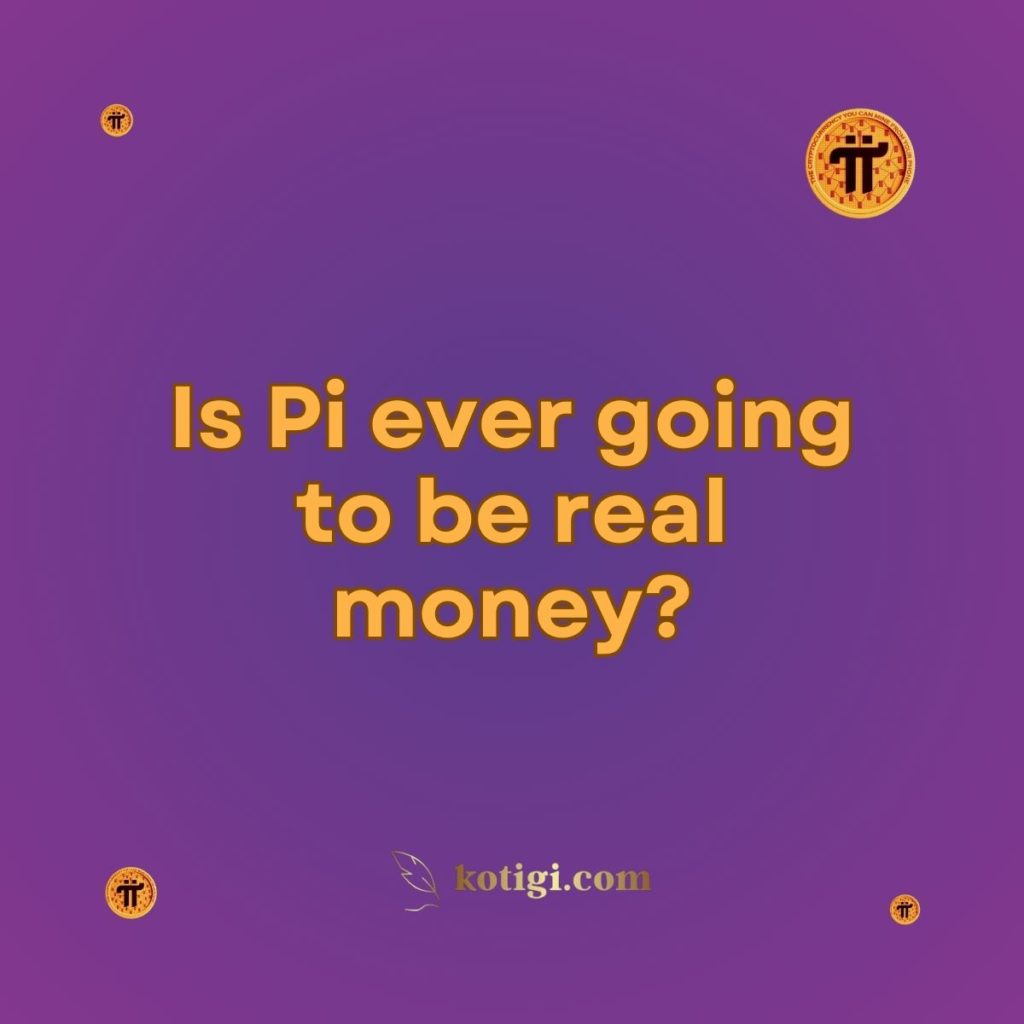
Is Pi ever going to be real money?
Pi has the potential to become real money once it reaches the open mainnet and is publicly tradable. For now, it’s in the enclosed network phase, where it can only be used within the Pi ecosystem. The future of Pi as real money depends on its adoption, integration into the economy, and successful listing on exchanges.
Introduction
Pi Network has generated a lot of interest due to its unique approach to cryptocurrency mining via mobile devices. With millions of users actively mining Pi, the burning question for many is: Will Pi ever become real money? The answer to this depends on several factors, including its transition to the open mainnet, exchange listings, adoption, and utility. Let’s dive into the potential future of Pi as real currency.
Understanding Pi’s Current Status
Pi Network Phases
Pi Network is still in its development stages, currently in what is known as the enclosed mainnet phase. In this phase, Pi cannot be exchanged on public cryptocurrency exchanges or converted into traditional fiat currencies like the U.S. dollar. Instead, Pi can only be used within the network for transactions between users and for testing purposes in a closed environment.
The project aims to move to an open mainnet phase, where Pi will become a tradable asset on cryptocurrency exchanges, allowing users to sell or buy it just like any other cryptocurrency.
When Will Pi Become Tradable?
The transition to the open mainnet is highly anticipated by Pi users and investors. However, the exact timing depends on several factors, such as:
- KYC Verification Completion: Only users who have completed the Know Your Customer (KYC) process will be able to use Pi once it becomes tradable. This step is critical for ensuring that Pi is held by legitimate, real users and not by bots or fraudulent accounts.
- Security and Stability of the Network: Before launching the open mainnet, Pi Network must ensure that its system is secure, scalable, and ready for public trading.
What Does It Mean for Pi to Become “Real Money”?
Definition of Real Money
For Pi to be considered real money, it must meet certain criteria:
- Tradability: It must be easily exchanged for other assets, such as fiat currencies or cryptocurrencies, on recognized exchanges.
- Utility: It should be accepted as a form of payment for goods and services, either in online marketplaces or in physical stores.
- Store of Value: Pi must hold value that people trust and can rely on for storing wealth or making transactions.
Currently, Pi is not “real money” in the traditional sense because it cannot be exchanged for cash, and its value is not yet determined by market forces.
Pi’s Potential to Become Real Money
Exchange Listings
The most critical step toward Pi becoming real money is being listed on major cryptocurrency exchanges. Once Pi reaches the open mainnet phase, it will be tradable on exchanges like Binance, Coinbase, or Kraken. This will allow users to sell their Pi coins for other cryptocurrencies or fiat currencies, giving Pi a real-world value.
Utility in Real-World Transactions
Another key aspect of Pi becoming real money is its ability to be used for purchasing goods and services. The Pi Network team has plans for a marketplace within its ecosystem where users can exchange Pi for products, services, or digital assets. If Pi gains traction in these marketplaces and is accepted by merchants, it could gain credibility as a legitimate form of currency.
Pi’s Mobile Mining Model
One of Pi’s unique advantages is its mobile mining model, which allows users to mine Pi directly from their smartphones without consuming significant energy resources. This easy access to mining could encourage broader adoption and usage, especially in regions where traditional banking systems or cryptocurrency mining are less accessible. As more people mine and hold Pi, its value and utility could increase, contributing to its future as real money.
Challenges to Pi Becoming Real Money
Market Competition
The cryptocurrency market is highly competitive, with established coins like Bitcoin, Ethereum, and Litecoin already dominating the space. For Pi to succeed, it needs to differentiate itself and prove that it offers unique advantages over these established coins. Pi’s mobile mining and focus on creating a more inclusive financial system could help it stand out, but it will still face challenges in gaining market share.
Regulatory Approval
One potential hurdle for Pi is regulatory approval in various countries. Governments around the world are increasingly scrutinizing cryptocurrencies, with some imposing regulations that make it difficult for new cryptocurrencies to gain traction. Pi Network will need to navigate these regulations carefully, especially when it comes to KYC compliance, data privacy, and anti-money laundering (AML) measures.
Establishing Value
Since Pi is not yet publicly traded, its current value is speculative. When Pi becomes tradable on exchanges, the market will determine its price based on supply and demand. There is always the risk that Pi’s value could start low, especially if there is an oversupply of coins or limited demand. However, if Pi can successfully establish real-world use cases and attract a large user base, its value could rise over time.
What Will Make Pi Valuable?
Utility in Decentralized Applications (dApps)
One way Pi could become valuable is through its use in decentralized applications (dApps). Pi’s blockchain infrastructure could allow developers to build applications that rely on Pi for transactions, creating more demand for the currency. If Pi becomes a core part of decentralized finance (DeFi) platforms or is integrated into various applications, it could significantly increase its utility and value.
Merchant Acceptance
For Pi to become real money, it must be widely accepted by merchants and businesses. If Pi can develop partnerships with online retailers, digital platforms, or even physical stores, it could gain credibility as a legitimate payment method. Similar to how Bitcoin started being accepted by some businesses, Pi’s acceptance in commerce would be a major step toward it becoming real money.
Global User Base
Pi Network has already attracted millions of users worldwide, which gives it a significant advantage over newer cryptocurrencies. This large user base could create demand for Pi coins, especially once they become tradable on exchanges. If Pi can maintain and grow its user community while providing real-world utility, its potential as real money becomes more viable.
Will Pi Ever Reach the Value of Bitcoin?
Pi vs. Bitcoin
Many people compare Pi to Bitcoin, asking if Pi could ever reach the same level of success. While Bitcoin is the pioneer of cryptocurrencies and has established itself as a store of value, Pi is still in its early stages. Pi’s success depends on different factors than Bitcoin, such as mass adoption, real-world utility, and ease of access through mobile mining.
However, it’s unlikely that Pi will reach Bitcoin’s current value in the near term. Bitcoin’s scarcity (only 21 million coins will ever exist) has played a significant role in driving its value. Pi, on the other hand, has a much higher total supply, which could limit its price growth.
Future Value of Pi
The future value of Pi will depend on market demand, its use in real-world transactions, and the success of its development roadmap. While it may not reach Bitcoin’s level, Pi could still achieve a stable and valuable position in the cryptocurrency market if it successfully transitions to the open mainnet and gains widespread adoption.
Conclusion
Pi Network has the potential to become real money, but its success hinges on several factors, including its transition to the open mainnet, exchange listings, and real-world utility. If Pi is accepted by merchants, integrated into dApps, and traded on major exchanges, it could achieve the status of real money. However, the road ahead is challenging, and only time will tell whether Pi can overcome these obstacles and become a legitimate currency.
Key Takeaways:
- Pi has the potential to become real money once it reaches the open mainnet and becomes tradable on exchanges.
- Its future depends on adoption, utility, and market demand.
- Mobile mining makes Pi accessible, but market competition and regulatory challenges remain.
- The success of Pi as real money hinges on its use in real-world transactions and decentralized applications.
- Pi is unlikely to reach the value of Bitcoin but could establish its own niche in the cryptocurrency market.





